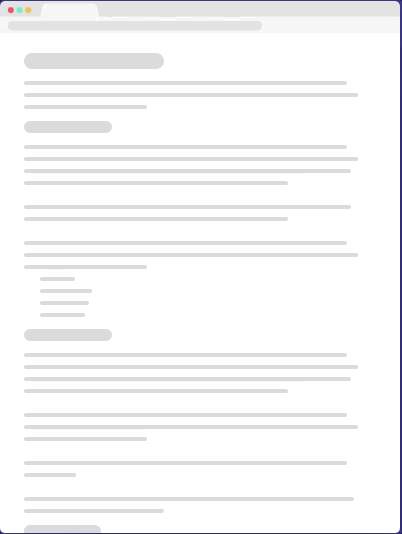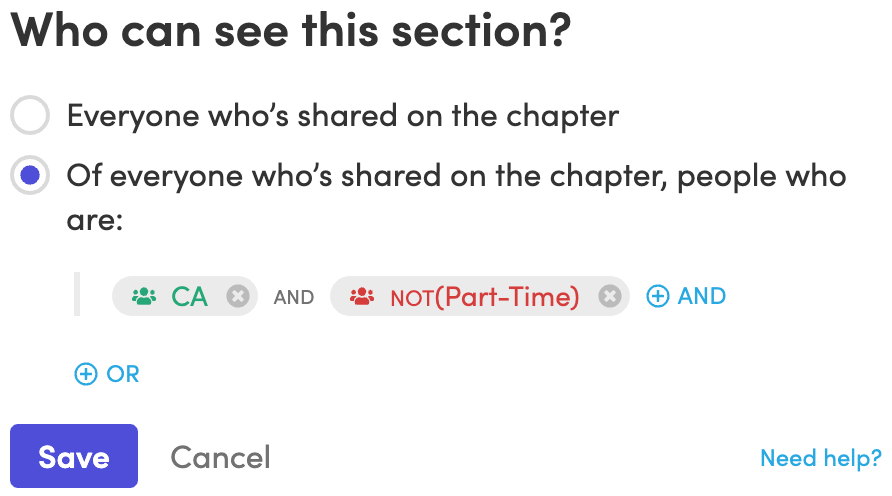Employee Handbook vs. Policy Manual: Differences
“Employee handbook” and “policy manual” might sound like interchangeable terms, but they’re two separate items, each with their own distinct purpose.
By understanding the differences between an employee handbook and a policy manual, your company can ensure the right people have access to the appropriate level of information. Properly documented and communicated policies can also help you minimize liability risks in the workplace.
In this article, we’ll break down everything you need to know about employee handbooks and policy manuals, including their purpose, contents, and requirements.
We’ll also highlight the main differences between the two documents.
Let’s take a closer look at how to distinguish between employee handbooks and policy manuals.
What is an Employee Handbook?
An employee handbook is a company resource that provides employees with helpful information about working at your organization. It should be created in a way that’s easy to understand. In other words, you should avoid, minimize, or hide legalese or overly formal language.
This increases the likelihood that your employees will actually read and generally understand your policies, which is a win-win situation for everyone.
Generally speaking, your employee handbook offers a high-level overview of your employee expectations as well as your company’s commitments to its people.
For a more detailed explanation, check out this article: What is an Employee Handbook?
What is a Policy Manual?
A policy manual is a helpful resource for the people who oversee your policies, like your HR team, leadership, and managers. It’s more comprehensive than an employee handbook because it’s geared toward policy administration.
Policy manuals provide the necessary details, including procedures to follow and forms to use. They might also explain the relevant employment laws that correspond with each policy.
Since a policy manual isn’t intended for widespread employee use, it can include in-depth guidance to help make complex situations easier on administrators — e.g. examples of what to say in certain scenarios or how to approach tough topics.
Purpose: Employee Handbook vs. Policy Manual
Although employee handbooks and policy manuals cover similar topics, each has its own unique purpose.
Your employee handbook has a well-defined target audience: your employees.
Your employee handbook should empower employees to better understand and meet expectations, and provide answers to common employee questions.
Your policy manual is intended for the people who will oversee your company’s policies, such as your HR department, company leaders, and managers.
A policy manual provides further guidance on actual policy administration, which explains policies and processes in more detail than the typical employee needs to know.
In short, employee handbooks are general and written for all employees.
Policy manuals are more exhaustive and help supervisory employees understand and execute your organization’s policies.
Contents: Employee Handbook vs. Policy Manual
Employee handbooks are sometimes perceived as documents outlining “how not to get in trouble,” but they can and should be so much more.
At Blissbook, for example, we believe employee handbooks should promote your company culture, especially when making a first impression (i.e., during new employee onboarding). You should highlight your company’s mission, vision, and values so employees get to know “you, the organization” better.
Your employee handbook should include high-level policy overviews, basic benefits information, and how your company handles certain things.
If you try to get too granular, you’ll end up with a very long document and consequently, your employees won’t read it. You can’t provide every detail or possible scenario, so don’t even try. Instead, give employees the general rundown and tell them who to contact or where to go for specifics.
Note: Documents in Blissbook can use “read more” buttons to hide nitty-gritty content behind a button. On the surface, an employee handbook looks like a 5-10 page, approachable overview of your company’s policies. However, employees who want more details can click the button or find “hidden” details if they search the document. See it in action on this demo handbook.

Consider your policy manual more like a governing document — i.e., bylaws.
A policy manual is more formal and operational than an employee handbook. Your policy manual should include steps to follow in certain situations, relevant resources (like forms, checklists, and templates), and laws related to employee rights. It’s a look behind the scenes at what makes the organization operate smoothly.
Here’s a helpful way of looking at it.
Your employee handbook should include information about your company’s policy against harassment and what harassing behavior looks like in the workplace, as well as what to do if an employee witnesses violations.
Your policy manual, on the other hand, provides guidance for managers on how to field these employee concerns. For example, questions like how to formally document the employee’s complaint, helpful things to say to the employee, as well as what to do next depending on the severity of the situation.
Let’s take performance evaluations as another example.
Your employee handbook tells employees about the evaluation process, its frequency, and what the evaluation means — e.g., performance improvement plans or promotion opportunities.
On the other hand, your policy manual might contain evaluation forms, a conversation guide, and performance improvement plan templates.
Employee handbooks are approachable and provide employees with the right level of information to understand the basics without suffering from content overload or an impromptu nap.
Policy manuals are more formal and provide administrators with all the ins and outs they need to ensure your company’s policies are applied as intended.
Note: Blissbook helps you organize this content in several ways:
- Hide nitty-gritty details of policies behind a “read more” button.
- Create separate Manager Manuals to live alongside your Employee Handbook and can share them only with Managers – an audience member dashboard allows employees to search across all the documents they have access to in one place.
- Blissbook’s personalized content functionality allows you to restrict access to certain content within a single document. You can have manager-only sections or call-out boxes that only managers can see.
- You can link from any Blissbook document out to your intranet or to anywhere else you want to store those nitty-gritty details.

Legal and Compliance Requirements: Employee Handbook vs. Policy Manual
Employee handbooks and policy manuals are valuable tools that help companies comply with employment laws and regulations.
Together, these documents provide employees, leaders, and employers with the information they need to build a relationship of mutual understanding while ensuring everyone knows their rights.
Once your employees have signed off that they’ve received, read, and will comply with your employee handbook, your company is better situated to enforce the handbook’s policies.
In other words, it’s much easier to administer your policies if you’re starting from a place of agreement.
If your employees understand acceptable technology uses, you can approach them with concerns about improper usage.
If you’ve provided expectations regarding safety, your workplace should be more secure. Thorough policy documentation leads to a more compliant work environment.
Policy manuals promote fairness by ensuring policies are consistently and compliantly implemented throughout your organization — a benefit for everyone.
An effective policy manual also helps employers mitigate legal risks in the workplace.
Common HR risk areas include hiring and terminations; health and safety matters; pay and benefits; employee conduct; and compliance with laws and regulations. You can help your company reduce risk by developing written documentation related to these areas of possible concern.
The more employees you hire, the greater the compliance requirements. When companies reach 15 employees, for example, they must adhere to the provisions of the Americans with Disabilities Act (ADA), Genetic Information Nondiscrimination Act (GINA), Pregnancy Discrimination Act (PDA), and Title VII of the Civil Rights Act of 1964.
While employers must communicate to employees that they will comply with and enforce these laws, actual compliance is paramount. At a company size of 15, it may be more critical that leaders know the ins and outs of how to do that (policy manual) than to give employees an overview of the requirement (employee handbook).
Ideally, your employee handbook arms employees with the information they should know, while your policy manual provides the details that guide the individuals overseeing these policies.
In tandem, your employee handbook and policy manual facilitate compliance and mitigate legal risk.
Other Differences: Employee Handbook vs. Policy Manual
You may be starting from scratch and find yourself unsure which to tackle first. If you start with the employee handbook, you can better identify what matters from a company culture standpoint, then carefully craft a policy that aligns with those values and priorities.
Regardless of order, you should always review both documents when making updates. It is not uncommon for a policy manual and an employee handbook to be drafted simultaneously — or for the detailed policy information to be initially crafted as part of the employee handbook.
Both documents help promote continuity regardless of other organizational changes. If policies and procedures are thoroughly documented, you eliminate the opportunity for loose interpretations.
Your policy manual enhances your employee handbook by drilling down into the details.
A robust manual empowers policy administrators to make simple decisions in difficult situations.
If the policy manual guides what to do in each situation, your HR teams and supervisors won’t have to make burdensome choices; they’ll just reference the policy manual.
This benefits everyone by creating an environment where employees are treated fairly and consistently.
Summary Table: Employee Handbook vs. Policy Manual
| Employee Handbook | Policy Manual | |
|---|---|---|
| Audience | Employees | HR team / managers / leadership (plus employees in specific situations) |
| Voice/Tone | Approachable and easy to understand; promotes company culture | Can be more formal and procedural; consider it a tool |
| Level of Detail | General overview without inundating employees with excessive detail | More elaborate to enable administrators to fully understand and implement policies |
| Compliance | Provides employees with the information they need to comply with your policies | Explains the ins and outs of each policy to ensure consistency and compliance |
Final Thoughts – Employee Handbook vs. Policy Manual: Which One Should You Use?
Now that we’ve equipped you with a better understanding of each document — employee handbook and policy manual — you might be wondering which you should use.
It’s best practice to have both an employee handbook and a policy manual as long as there are no discrepancies. Otherwise, you could inadvertently create additional liability when you intended to avoid it.
Just remember that employee handbooks should be approachable, digestible, and written with employees in mind.
In contrast, policy manuals delve into the intricacies that enable HR teams and managers to ensure policy adherence.
Since each document has its own audience and distinct purpose, it should be easy to determine the best fit depending on your goal.
Blissbook makes it simple to create an employee-friendly digital handbook. You can easily showcase your company culture using videos, timelines, and more.
The platform’s “Read More” feature enables you to provide a high-level policy overview and hide details in an expandable section — yielding an employee handbook that’s not so overwhelming.
Many customers come to us with what they think will be a complex multiple-document situation involving multiple linking between documents.
Instead, they simply use the “Read More” button to put all the content in a single place, making it easy for employees to access and easy for editors to manage.
To learn more about Blissbook’s employee handbook capabilities, sign up or request a demo today.